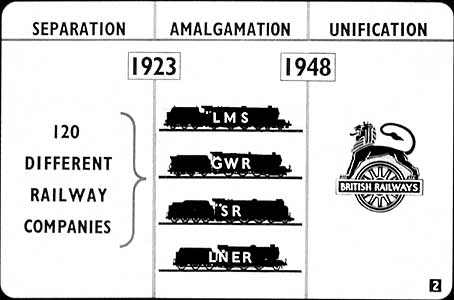

2) In this diagram you’ve got the three stages in what might be called the constitutional history of British Railways – separation, amalgamation and unification.
Over on the left is the stage of separation, in which Britain was covered with all sorts of independent railway companies, some small, some great. In 1923 these railways were amalgamated into the L.M.S., L.N.E.R., G.W.R., and Southern. And, in turn, the locomotives which represent the big four companies are shown going to nationalisation junction 1948, there to turn into the British Railways crest which symbolises the unity of railway transport throughout Britain.
But that’s only one side of railway history. There’s another side too – the history of how locomotives first began to run on rails, and how trains developed. The railways were a purely British achievement. In 1802, an engineer named Richard Trevithick designed a steam locomotive which ran round a circular track in Euston Square, London, and in 1814 George Stephenson built his first locomotive...